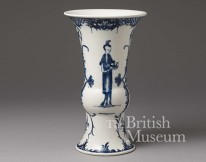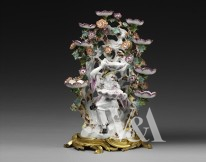8 Chinoiserie

Chinese influence has had a significant impact on European architecture, interior decoration, furniture, metalwork, paintings, textile designs and even gardens, as well as on ceramic productions. It was particularly strong from the late 17th century to the end of the 18th century, although porcelain made in Italy aspired to copy Chinese examples as early as the 16th century. ‘Chinoiserie’, originally a French word, describes a style marked by the adaptation of Chinese sources, often in a fanciful manner which projected an imaginary China. The famous and ever-popular ‘Willow Pattern’ design on pottery and porcelain is a purely European invention in this vein.
Few European travellers reached China. Its distance from Europe and its unfamiliarity allowed a romantic vision of China to flourish, expressed by way of pagodas, men fishing, cormorants, prunus, peonies, chrysanthemums and phoenixes which were all common on European ceramics.
The technique of painting under the glaze in cobalt blue was taken directly from Chinese porcelain, but the motifs used in Europe were almost always adaptations for the European market and often betray little understanding of their original source. Blue and white delftware (tin-glazed earthenware) and porcelain in Chinese style was produced in huge quantities at European factories.




